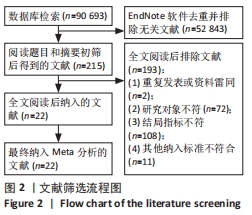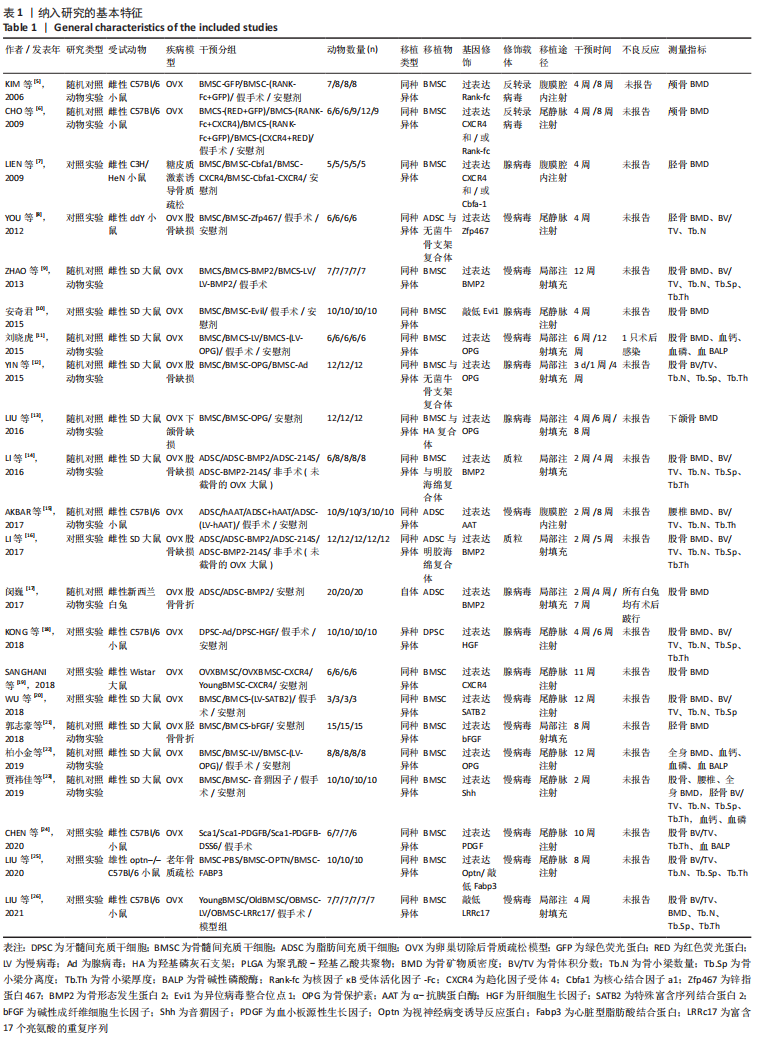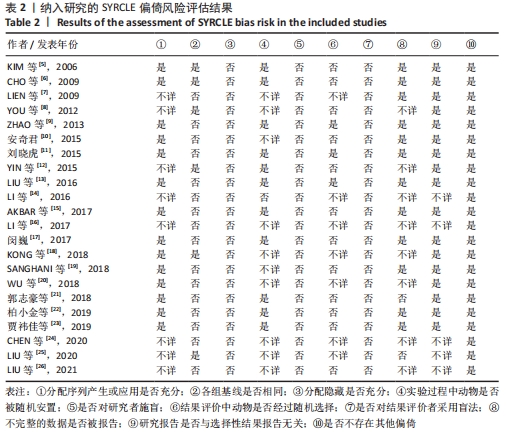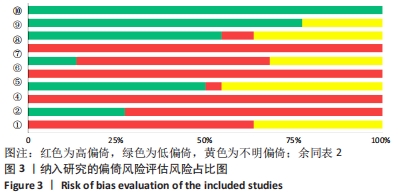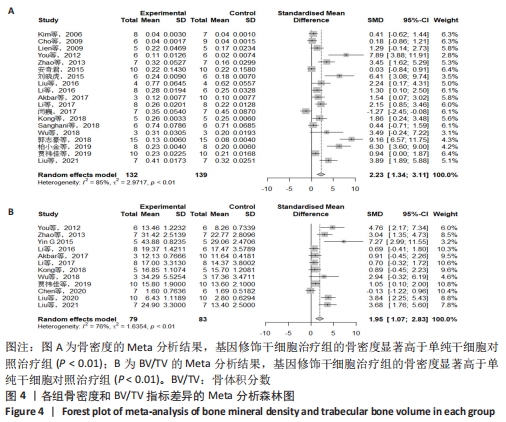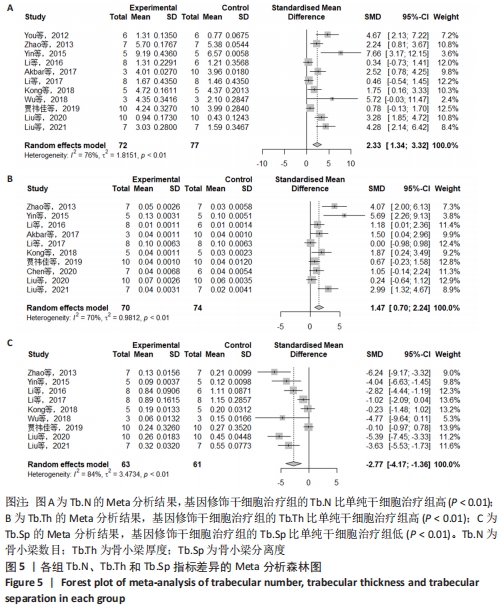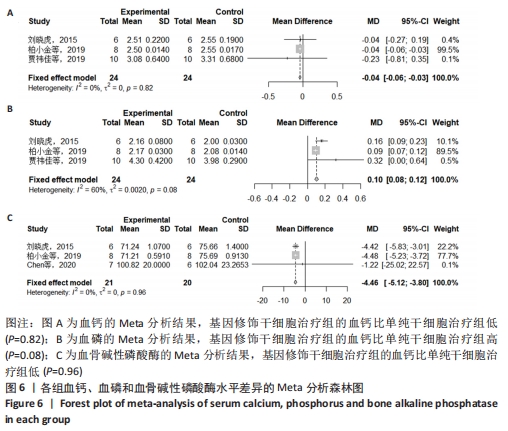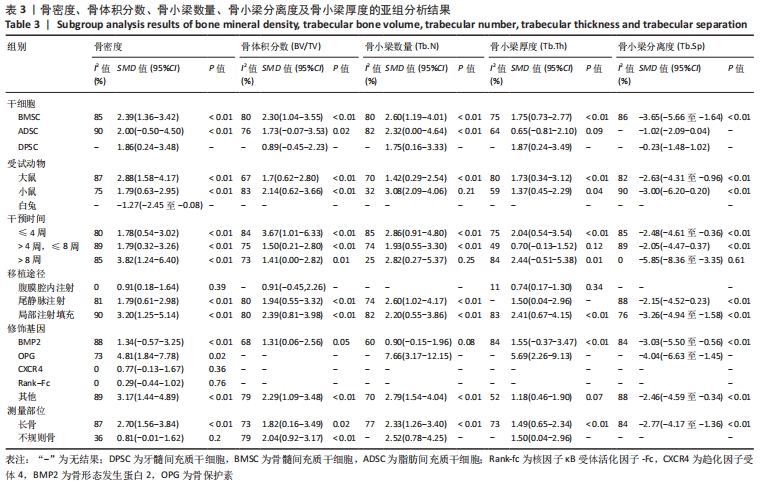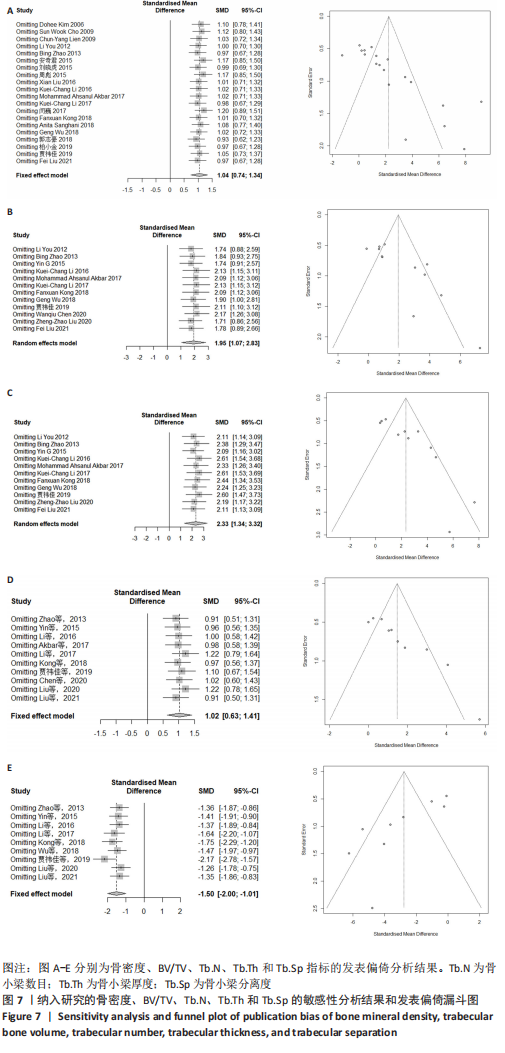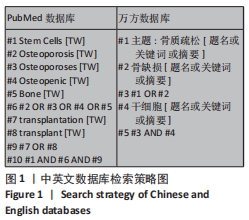[1] 白璧辉,谢兴文,李鼎鹏,等.我国近5年来骨质疏松症流行病学研究现状[J].中国骨质疏松杂志,2018,24(2):253-258.
[2] XIONG Z, YI P, LIN J, et al. Evaluation of the efficacy of stem cell therapy in ovariectomized osteoporotic rats based on micro-ct and dual-energy x-ray absorptiometry: a systematic review and meta-analysis. Stem Cells Int. 2021;2021:1439563.
[3] JIANG Y, ZHANG P, ZHANG X, et al. Advances in mesenchymal stem cell transplantation for the treatment of osteoporosis. Cell Prolif. 2021;54(1):e12956.
[4] HOOIJMANS CR, ROVERS MM, de VRIES RB, et al. SYRCLE’s risk of bias tool for animal studies. BMC Med Res Methodol. 2014;14:43.
[5] KIM D, CHO SW, HER SJ, et al. Retrovirus-mediated gene transfer of receptor activator of nuclear factor-kappaB-Fc prevents bone loss in ovariectomized mice. Stem Cells. 2006;24(7):1798-1805.
[6] CHO SW, SUN HJ, YANG JY, et al. Transplantation of mesenchymal stem cells overexpressing RANK-Fc or CXCR4 prevents bone loss in ovariectomized mice. Mol Ther. 2009;17(11):1979-1987.
[7] LIEN CY, CHIH-YUAN HK, LEE OK, et al. Restoration of bone mass and strength in glucocorticoid-treated mice by systemic transplantation of CXCR4 and cbfa-1 co-expressing mesenchymal stem cells. J Bone Miner Res. 2009;24(5):837-848.
[8] YOU L, PAN L, CHEN L, et al. Suppression of zinc finger protein 467 alleviates osteoporosis through promoting differentiation of adipose derived stem cells to osteoblasts. J Transl Med. 2012;10:11.
[9] ZHAO B, WANG Q, TAO T, et al. The in vitro and in vivo treatment effects of overexpressed lentiviral vector-mediated human BMP2 gene in the femoral bone marrow stromal cells of osteoporotic rats. Int J Mol Med. 2013;32(6):1355-1365.
[10] 安奇君.抑制Evi1基因表达促进BMSCs成骨分化治疗骨质疏松症的研究[D].太原:山西医科大学,2015.
[11] 刘晓虎.携带OPG基因的慢病毒转染骨髓间充质干细胞治疗骨质疏松大鼠的效果研究[D].太原:山西医科大学,2015.
[12] YIN G, CHEN J, WEI S, et al. Adenoviral vector-mediated overexpression of osteoprotegerin accelerates osteointegration of titanium implants in ovariectomized rats. Gene Ther. 2015;22(8): 636-644.
[13] LIU X, BAO C, XU H, et al. Osteoprotegerin gene-modified BMSCs with hydroxyapatite scaffold for treating critical-sized mandibular defects in ovariectomized osteoporotic rats. Acta Biomater. 2016;42:378-388.
[14] LI KC, CHANG Y H, YEH CL, et al. Healing of osteoporotic bone defects by baculovirus-engineered bone marrow-derived MSCs expressing microRNA sponges. Biomaterials. 2016;74:155-166.
[15] AKBAR MA, LU Y, ELSHIKHA AS, et al. Transplantation of adipose tissue-derived mesenchymal stem cell (ATMSC) expressing alpha-1 antitrypsin reduces bone loss in ovariectomized osteoporosis mice. Hum Gene Ther. 2017;28(2):179-189.
[16] LI KC, CHANG YH, HSU MN, et al. Baculovirus-mediated mir-214 knockdown shifts osteoporotic ASCs differentiation and improves osteoporotic bone defects repair. Sci Rep. 2017;7(1):16225.
[17] 闵巍.腺病毒介导hBMP-2转染ADSCs治疗兔骨质疏松性骨折的实验研究[D].遵义:遵义医学院,2017.
[18] KONG F, SHI X, XIAO F, et al. Transplantation of hepatocyte growth factor-modified dental pulp stem cells prevents bone loss in the early phase of ovariectomy-induced osteoporosis. Hum Gene Ther. 2018;29(2): 271-282.
[19] SANGHANI A, OSAGIE-CLOUARD L, SAMIZADEH S, et al. CXCR4 has the potential to enhance bone formation in osteopenic rats. Tissue Eng Part A. 2018;24(23-24): 1775-1783.
[20] WU G, XU R, ZHANG P, et al. Estrogen regulates stemness and senescence of bone marrow stromal cells to prevent osteoporosis via ERbeta-SATB2 pathway. J Cell Physiol. 2018;233(5):4194-4204.
[21] 郭志豪,刘晓潭,刘槃,等.骨髓间充质干细胞过表达碱性成纤维细胞生长因子对骨质疏松性骨折大鼠的治疗作用[J].中华实验外科杂志,2018,35(3):505-508.
[22] 柏小金,黄文良,柏帆,等.骨保护素基因修饰的骨髓间充质干细胞治疗大鼠骨质疏松[J].中国老年学杂志,2019,39(13): 3245-3249.
[23] 贾祎佳,罗春山,陆廷盛,等.音猬因子修饰的骨髓间充质干细胞治疗大鼠骨质疏松的实验研究[J].中华老年骨科与康复电子杂志,2019,5(4):211-216.
[24] CHEN W, WASNIK S, FU Y, et al. Unique anabolic action of stem cell gene therapy overexpressing PDGFB-DSS6 fusion protein in OVX osteoporosis mouse model. Bone Rep. 2020;12:100236.
[25] LIU ZZ, HONG CG, HU WB, et al. Autophagy receptor OPTN (optineurin) regulates mesenchymal stem cell fate and bone-fat balance during aging by clearing FABP3. Autophagy. 2020;17(10):2766-2782.
[26] LIU F, YUAN Y, BAI L, et al. LRRc17 controls BMSC senescence via mitophagy and inhibits the therapeutic effect of BMSCs on ovariectomy-induced bone loss. Redox Biol. 2021;43:101963.
[27] BENISCH P, SCHILLING T, KLEIN-HITPASS L, et al. The transcriptional profile of mesenchymal stem cell populations in primary osteoporosis is distinct and shows overexpression of osteogenic inhibitors. PLoS One. 2012;7(9):e45142.
[28] XIA L, XU Y, CHANG Q, et al. Maxillary sinus floor elevation using BMP-2 and Nell-1 gene-modified bone marrow stromal cells and TCP in rabbits. Calcif Tissue Int. 2011; 89(1):53-64.
[29] LIU X, BAO C, XU H, et al. Osteoprotegerin gene-modified BMSCs with hydroxyapatite scaffold for treating critical-sized mandibular defects in ovariectomized osteoporotic rats. Acta Biomater. 2016;42: 378-388.
[30] BOBIS-WOZOWICZ S, MIEKUS K, WYBIERALSKA E, et al. Genetically modified adipose tissue-derived mesenchymal stem cells overexpressing CXCR4 display increased motility, invasiveness, and homing to bone marrow of NOD/SCID mice. Exp Hematol. 2011;39(6):686-696.
[31] 张雪丽,汤光宇.影像新技术在骨质疏松疗效评估中的研究进展[J].国际医学放射学杂志,2017,40(5):547-551.
[32] 李建赤,黄必留,徐自强.骨组织形态计量学在临床骨病应用中的研究与进展[J].中国组织工程研究与临床康复,2011, 15(35):6607-6610.
[33] 伍金秋,钟清.血清碱性磷酸酶在慢性肾脏病矿物质和骨代谢紊乱发生发展中作用的研究进展[J].山东医药,2018,58(21): 102-105.
[34] WALMSLEY G G, RANSOM R C, ZIELINS E R, et al. Stem cells in bone regeneration. Stem Cell Rev Rep. 2016;12(5):524-529.
[35] 游斌,黄秀珠,林煜,等.自然衰老大鼠不同部位骨组织形态、骨密度及骨代谢指标的变化[J].中国组织工程研究,2021, 25(26):4118-4122.
|

